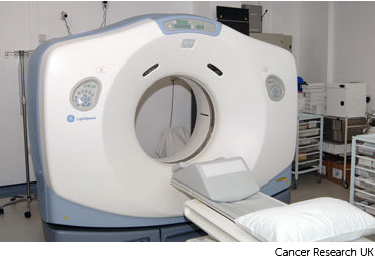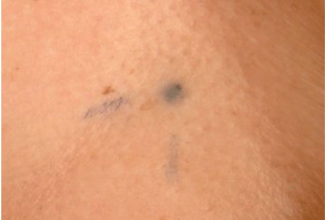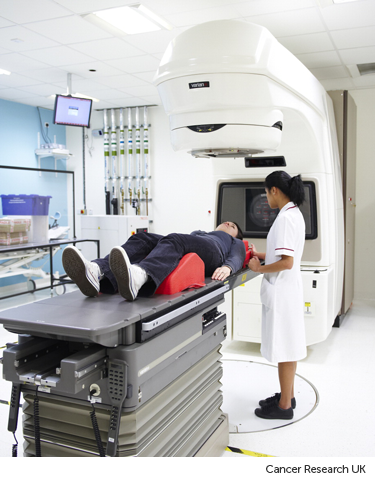Radiotherapy for melanoma skin cancer
Radiotherapy uses high energy x-rays to treat cancer cells. It isn't a common treatment for melanoma skin cancer.
When do you have radiotherapy for melanoma skin cancer?
Sometimes your doctor might recommend radiotherapy:
- if you can’t have surgery to remove a stage 3 melanoma
- to control symptoms of melanoma that has spread elsewhere in the body. This is called advanced melanoma
Rarely, your doctor may suggest radiotherapy:
- after surgery for stage 3 melanoma – this is called adjuvant radiotherapy
- if you can’t have surgery to remove melanoma that has spread towards, but not as far as, the lymph nodes (in-transit metastases)
Radiotherapy to help control symptoms
Radiotherapy for advanced melanoma aims to relieve symptoms and improve a person’s quality of life.
Where the cancer has spread to is called a metastasis or secondary cancer. If there are a small number of metastases that are causing symptoms, your doctor might recommend radiotherapy to areas including your:
- skin further away from the original (primary) melanoma
- lungs
- liver
- bone
- brain
How you have radiotherapy
There are different types of radiotherapy. For melanoma skin cancer, your doctor usually recommends external radiotherapy. This means using a machine to aim the radiotherapy beams at the cancer from outside your body.
If you have advanced melanoma skin cancer
The type of radiotherapy you have depends on where the melanoma has spread to. This might include a type of external radiotherapy called stereotactic radiotherapy (SRT). Or you may have other types.
Some people may have internal radiotherapy for cancer that has spread to the liver.
If the cancer has spread to your brain, your doctor may suggest you have whole brain radiotherapy (WBRT). You may also have SRT. When SRT is used to treat cancer in the brain it is called stereotactic radiosurgery.
How often do you have radiotherapy?
Your doctor might recommend a single treatment or a number of them over a few days. This depends on:
- whether you are also having other treatments for the melanoma
- the part of the body being treated
- what symptoms you have
Each treatment is called a fraction. You have one fraction a day. If you are having more than one fraction, you have them over a number of days.
You normally have radiotherapy treatment between Monday and Friday. You don’t normally have treatment on a weekend. This lets the body rest.
Radiotherapy doesn’t hurt but you may find laying on the radiotherapy couch uncomfortable.
Planning radiotherapy for melanoma skin cancer
The radiotherapy team plan your external radiotherapy before you start treatment. This means working out the dose of radiotherapy you need and exactly where you need it.
Your planning appointment takes from 15 minutes to 2 hours.
Before your planning starts, your doctor or radiographer asks you to sign a consent form. They will ask if you might be pregnant. If there is a chance, they will ask to do a pregnancy test. They will also remind you not to get pregnant during treatment. This is because radiation can damage an unborn baby.
At your planning appointment
You usually have a planning CT scan in the radiotherapy department.
The scan shows the cancer and the area around it. You might have other types of scans or x-rays to help your treatment team plan your radiotherapy. The plan they create is just for you.

Your radiographers tell you what is going to happen. They help you into position on the scan couch. You might have a type of firm cushion called a vacbag to help you keep still.
The CT scanner couch is the same type of bed that you lie on for your treatment sessions. You need to lie very still. Tell your radiographers if you aren't comfortable.
Injection of dye
You might need an injection of contrast into a vein in your hand. This is a dye that helps body tissues show up more clearly on the scan.
Before you have the contrast, your radiographer asks you about any medical conditions or allergies. Some people are allergic to the contrast.
Having the scan
Once you are in position your radiographers put some markers on your skin. They move the couch up and through the scanner. They then leave the room and the scan starts.
The scan takes about 5 minutes. You won't feel anything. Your radiographers can see and hear you from the CT control area where they operate the scanner.
Ink and tattoo marks
The radiographers make pin point sized tattoo marks on your skin. They use these marks to line you up into the same position every day. The tattoos make sure they treat exactly the same area for all of your treatments. They may also draw marks around the tattoos with a permanent ink pen, so that they are clear to see when the lights are low.

The radiotherapy staff tell you how to look after the markings. The pen marks might start to rub off in time, but the tattoos won’t. Tell your radiographer if that happens. Don't try to redraw them yourself.
Radiotherapy mould or mask
You might have a radiotherapy mould made to fit over a part of your body. The aim of the mould is to keep that part of your body very still. This makes sure that the radiotherapy is directed at exactly the same area every time you go for treatment.
For example, you might have a mask or mould to keep your head still if your melanoma is on your head or neck area. Or you might need a mould to keep an arm or leg still if you are having treatment to one of these areas.
Your radiotherapy team will explain how this is done if this applies to you.
After your planning session
You might have to wait a few days or up to 3 weeks before you start treatment.
During this time the physicists and your radiotherapy doctor (clinical oncologist) decide the final details of your radiotherapy plan. They make sure that the area of the cancer will receive a high dose and nearby areas receive a low dose. This reduces the side effects you might get during and after treatment.
Travelling to radiotherapy appointments
You might have to travel a long way each day for your radiotherapy. This depends on where your nearest cancer centre is. This can make you very tired, especially if you have side effects from the treatment.
You can ask your radiographers for an appointment time to suit you. They will do their best, but some departments might be very busy. Some radiotherapy departments are open from 7 am till 9 pm.
Car parking can be difficult at hospitals. Ask the radiotherapy staff if you are able to get free parking or discounted parking. They may be able to give you tips on free places to park nearby.
Hospital transport may be available if you have no other way to get to the hospital. But it might not always be at convenient times. It is usually for people who struggle to use public transport or have any other illnesses or disabilities. You might need to arrange hospital transport yourself.
Some people are able to claim back a refund for healthcare travel costs. This is based on the type of appointment and whether you claim certain benefits. Ask the radiotherapy staff for more information about this and hospital transport.
Some hospitals have their own drivers and local charities might offer hospital transport. So do ask if any help is available in your area.
The radiotherapy room
Radiotherapy machines are very big and could make you feel nervous when you see them for the first time. The machine might be fixed in one position. Or it might rotate around your body to give treatment from different directions. The machine doesn't touch you at any point.
Before your first treatment, your  will explain what you will see and hear. In some departments, the treatment rooms have docks for you to plug in music players. So you can listen to your own music while you have treatment.
will explain what you will see and hear. In some departments, the treatment rooms have docks for you to plug in music players. So you can listen to your own music while you have treatment.

During radiotherapy treatment
You need to lie very still. Your radiographers might take images (x-rays or scans) before your treatment to make sure that you're in the right position. The machine makes whirring and beeping sounds. You won’t feel anything when you have the treatment.
Your radiographers can see and hear you on a CCTV screen in the next room. They can talk to you over an intercom and might ask you to hold your breath or take shallow breaths at times. You can also talk to them through the intercom or raise your hand if you need to stop or if you're uncomfortable.
After radiotherapy
This type of radiotherapy won't make you radioactive. It's safe to be around other people, including pregnant women and children.
Side effects
Radiotherapy can cause side effects. Your doctor weighs up the benefits of giving radiotherapy against the side effects. They will discuss all the possible risks and benefits with you.
The side effects of radiotherapy for melanoma skin cancer vary depending on which part of your body you have treated. If you have radiotherapy just to the skin, you may only get side effects that affect the skin. It may be red, sore and itchy. The skin may also peel or blister. Side effects on the skin can start during or after treatment. They may last from a couple of weeks to over a month.
You might have some hair loss if you have radiotherapy to a part of the body that has hair. This will only be from the area where you had the treatment. Hair usually grows back after treatment but in some people the hair loss is permanent.



